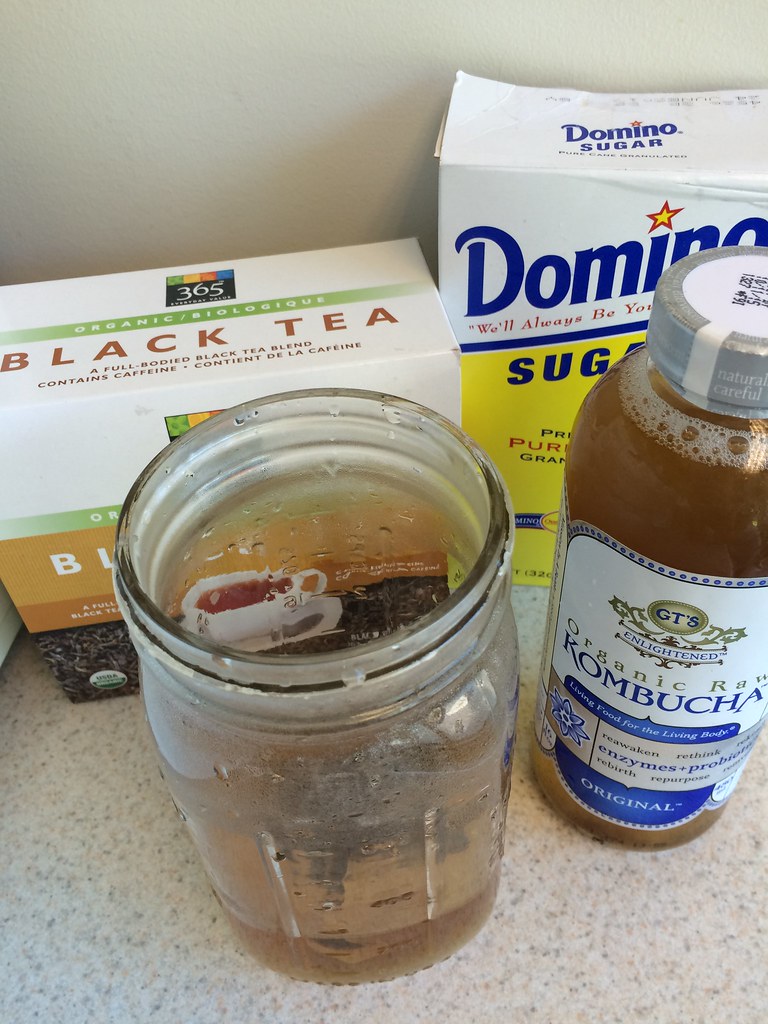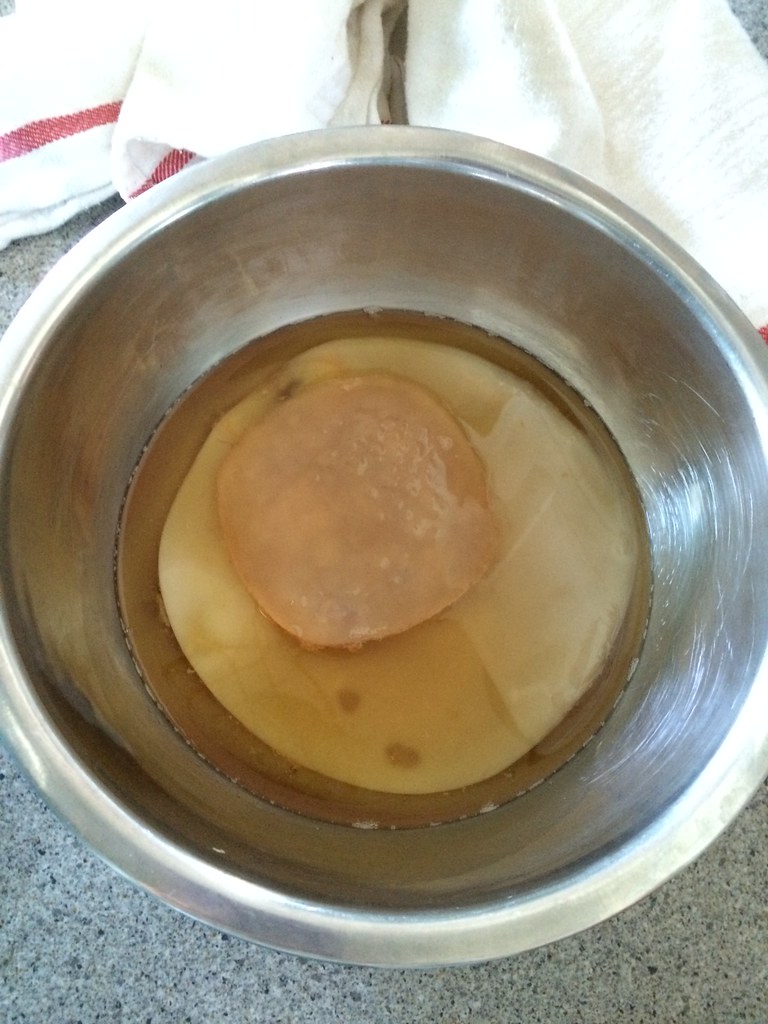Next, I'm coordinating a very exciting Portland Spirits Society (a group of women interested in learning about booze) event - a Bourbon and boozy chocolate truffle tasting with restaurant Grace and Dean's Sweets on October 1st at 6pm. The tickets are $25 (plus service fees) and include four samples of Bourbon and chocolate truffles. Spots are limited and tickets are going fast, so get yours soon if you're interested! Ladies only, please.
------
Now onto some recent food projects... my kombucha is finally finished! It tastes great, but it's not as fizzy as the store-bought stuff, so if anyone has any tips about a secondary fermentation, hit me up.
When we last chatted about kombucha, that intriguing, tangy fermented tea drink, I was growing my own SCOBY or starter from a batch of store-bought booch. Well, grow it did, and after a week, I had a new SCOBY that was ready to go.
I followed the recipe from Drink the Harvest by Nan K. Chase and DeNeice C. Guest, a beautifully done book that details how to make meads, ciders, syrups, and juices from fresh fruit and herbs.
Once I grew the SCOBY, I was ready to make the actual kombucha. To start, I brewed a batch of strong tea (2 cups of water, 8 organic black tea bags) and stirred in a cup of white sugar to the hot tea. I then let it cool down to room temperature and added 2 quarts (8 cups) of filtered water.
I poured this mix into a glass one-gallon container from Ball (not a canning jar, but good for fermenting) and added my new kombucha SCOBY, plus 1 cup of the tea/kombucha liquid in which it was growing. (This extra cup of liquid is to ensure that the next batch of kombucha is properly acidified so no nasties grow in it before the kombucha bacteria/yeast do their naturally acidifying thing.)
Above, you can see the first kombucha SCOBY I grew, over top of the one that grew in my one-gallon container. SCOBYs will grow to fit the container they're in, and so the second one is very wide. They're both in a cup of kombucha that I reserved, in a jar in my fridge, waiting until I need to make another eight cups of kombucha.
After ten days of fermenting, I tasted the kombucha and found it to be pretty tangy like I like it. I strained out the SCOBYs (reserving one cup of kombucha to go with them) then filled three quart jars with kombucha.
I was hoping to achieve a secondary fermentation in order to make it a little carbonated by adding a bit of honey and letting it sit, covered, at room temperature. Alas, no significant carbonation built up, so I strained it again and transferred it to the fridge for storage.
I added a bit of honey to the jars for my secondary fermentation, as suggest in The Art of Fermentation, hoping the kombucha yeast/bacteria would eat up the honey and produce some fizz. But I also read that kombucha needs sugar, not honey, to ferment, so maybe I should have added sugar instead.
Finally, I added some blueberry juice from Worcester's Wild Blueberries, to one of the jars, sent to me in my Box of Maine, a box of Maine-made goodies. I was thrilled to remember I had the juice in my fridge, because making fruit juice seemed like a daunting hurdle and probably wouldn't have happened. But now I have plain and blueberry homemade kombucha!
Kombucha
Adapted from Drink the Harvest by Nan K. Chase and DeNeice C. Guest
2 quarts, plus 2 cups filtered water
1 cup white sugar
8 black tea bags
1 kombucha SCOBY, plus 1 cup of SCOBY liquid
Boil two cups of water to a boil, and stir in sugar. Stir to dissolve. Add tea bags and let steep for 10 minutes. Remove tea bags and pour tea into a glass jar or ceramic crock with at least a half-gallon capacity. Add two quarts water and let cool to room temperature. Add SCOBY and reserved kombucha to the tea. Cover and let stand for 7-10 days.
Begin to taste kombucha after one week. When the flavor is to your liking, remove SCOBY and 1 cup of kombucha for your next batch. Filter kombucha and pour into jars or bottles. Add in 1/2-1 cup of fruit juice, a few tablespoons dried herbs, or a handful of fresh herbs for flavor, if desired. Keep in the refrigerator and use within one month.
-------
After vacation, I returned home to crisper drawers full of CSA vegetables. I guess I'd hoped they'd magically disappear while I was gone? Fortunately, none of them had liquefied, but they needed to be moved along, and fast. After all, there was another share arriving in short order.
Flipping through my new copy of The Backyard Homestead: Kitchen Know-How by Andrea Chesman, inspiration struck. She has a recipe for a vegetable base that uses up 8 cups of vegetables and stocks your freezer for future meals.
I chopped up every soup-related vegetable I could find: onions, celery, carrots, sweet peppers, summer squash, fennel, garlic scapes, and Swiss chard. I sauteed it until crisp-tender in a large stockpot, then added about two cups of tomato puree that I'd made in a separate pot with my garden tomatoes.
The whole thing made about four pints, or eight cups, of what I'm calling vegetable base. It's thick, so I can see diluting it with stock and adding beans, lentils, potatoes, and/or meat to make soup or just thawing it and serving it over some grain like couscous or quinoa, again with beans or meat.
I don't know why, but I felt so damn satisfied that I'd managed to get rid of heaps of produce in such a short time and in a way that I really feel like I'll use come cooler weather. Give it a whirl!
 |
| Frosty jars from the freezer |
Disclosure: I received complimentary copies of both books I mention as review copies, as well as a free sample of the Box of Maine service.




